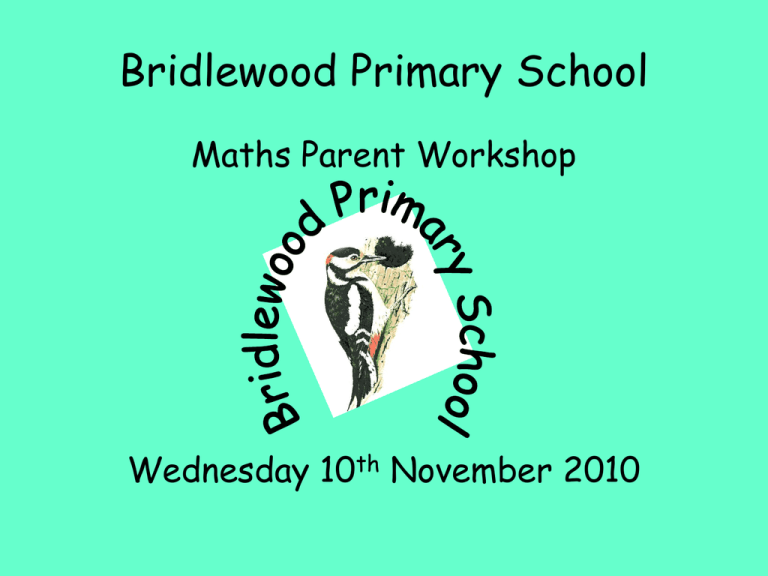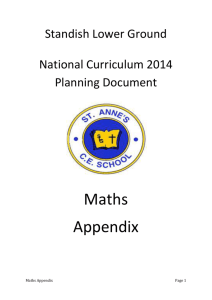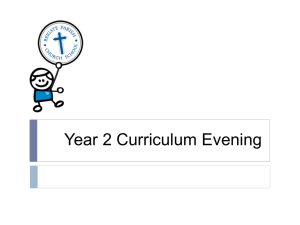PowerPoint - Bridlewood Primary School
advertisement

Bridlewood Primary School Maths Parent Workshop Wednesday 10th November 2010 Aims To explain how we teach your children +, -, x and ÷. To give you ideas of how you can help your children at home. How did you solve these? • 157+65= • 245-152= • 46x22= • 154÷7= Maths lessons • Emphasis on mental calculation • Children are encouraged to work mentally, using jottings to support their thinking • Encouraged to use more formal written methods only for calculations they can not solve in their heads • Maths through problem solving By the end of Key Stage 2 we want your children to… • Recall key number facts eg number bonds to 10 and associated bonds to 100. • Have good understanding of the 4 operations • Have an efficient, reliable method of calculation for each operation • Apply what they know • Use a calculator effectively Addition Addition Adding Practically Addition Encouraging children to put the biggest number in their head and count on. 3+5 +3 5 8 Addition Use of a number line 6+5= 1 2 3 4 5 6 7 8 9 10 11 12 13 Use of a 100 square 34+12= Partitioning Addition by partitioning 45 + 34 = Addition by partitioning 132+124= Your Turn 56+43= Addition using a blank number line 45+34= 185+44 = Your Turn! 85+44 Addition The Extended Method 425+48= Your turn - 266+233= Addition- Standard Written Method 6648+1486= Subtraction Subtraction Taking away practically. 3-2= Use of a number line/100 square 12-6=6 1 2 3 4 5 6 7 8 9 10 11 12 13 Subtraction using a blank number line 62 – 26 = Your turn! 78-44= Subtraction 654 – 96 = 654 - 96 4 (to make 100) 500 (to make 600) 54 (to make 654) 558 Add on to 96 the number that makes 100 Add on to 100 the number that makes 600 Add on to 600 the number that makes 654 Relates to the number line method as follows +4 96 +500 100 +54 600 654 500+54+4=558 Subtraction- Standard Written Method 553-241= 500+50+3 200+40+1 300+10+2 = 312 40+13 553-248= 500+50+3 200+40+8 300+0+ 5= 305 Multiplication Multiplication- repeated addition 3x5= (3 groups of 5) xx xx x 5 xx xx x + 5 xx xx x + 5= 15 Multiplication using a blank number line 4x3= Your turn - 6x8= Times tables • By end of Year 2 children should know x2,x5,x10 • Practise counting in 2’s, 3’s, 4’s, 5’s, 10’s • Matching pairs (question on one card, answer on another) • Musical times tables Multiplication by partitioning 32x3= Your turn - 45x6= Grid Method 32x7= 33x22= Your turn! - 34x23= Multiplication-Standard Written Method 352x27= 352 x27 2464 (352x7) 31 7040 (352x20) 1 9504 1 Division ÷ Sharing Division The children are sharing out into a known number of groups but how many in each group is unknown, 12÷3= ÷ 12 apples are shared into 3 baskets. How many apples are in each basket? Grouping Division ÷ It is known how many are in a group but the number of groups is not known. 12÷3= How many groups of 3 are there in 12? There are 12 apples. How many horses will get 3? Division using a blank number line 25÷5= 5 (How many groups of 5 are there in 25?) ÷ Your turn - 24÷6 Division- Chunking 96÷6= (How many groups of 6 are there in 96?) Fact Box 1x6=6 2x6=12 5x6=30 10x6=60 20x6=120 50x6= 300 100x6=600 522÷9= 58 Your Turn! Fact Box 1 x 9 = 9 2 x 9 = 18 5 x 9 = 45 10 x 9 = 90 20 x 9 = 180 50 x 9 = 450 100 x 9 = 900 Your Turn! 100÷7= Fact Box 1 x 7 = 7 2 x 7 = 14 5 x 7 = 35 10 x 7 = 70 20 x 7 = 140 50 x 7 = 350 100 x 7 = 700 How you can support your child • Look for and talk about numbers in the environment • Play games • Shopping • Counting on/back • Number bonds • Doubles/Halves • Times tables • Division facts Websites • http://nrich.maths.org/public/ • http://www.bbc.co.uk/schools/ks2bitesize/maths/ number.shtml • http://www.teachingtime.co.uk/ • http://www.teachingtables.co.uk • http://www.bbc.co.uk/schools/laac/menu.shtml • http://www.woodlandsjunior.kent.sch.uk/interactive/literacy/index.htm • http://www.coxhoe.durham.sch.uk/











